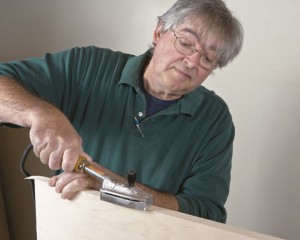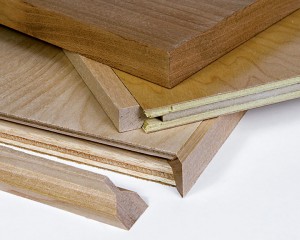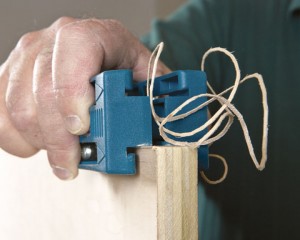 Remember those old Wisk detergent commercials where the announcer would disdainfully point out “those dirty rings!” Here’s the woodworking equivalent: those dirty plys.
Remember those old Wisk detergent commercials where the announcer would disdainfully point out “those dirty rings!” Here’s the woodworking equivalent: those dirty plys.
With the exception of Baltic birch and its various likenesses, where the plys are generally uniform and pretty enough to show off, we don’t want to see those “bad” plys on most projects. Particleboard edges are just as much a faux pas to leave bare. You can get away with it on a shop project, but not on a finished cabinet. At least MDF edges, which are generally left au naturel, kind of blend into their surroundings unnoticed.
 So, that begs the reason for this post. Generally, I hide the edges of sheet goods just like you do. I’ve used iron-on edge tape, but if I’m going to all the effort to hide plys, I usually want something more durable. So, solid-wood edging is my deal. I’ve used thicker strips reinforced with biscuits. Sometimes I’ll switch to tongue-and-groove joints when applying wider shelf edging. It adds structure and is self-aligning. And, of course, I’ve applied thinner strips of hardwood with brad nails and glue.
So, that begs the reason for this post. Generally, I hide the edges of sheet goods just like you do. I’ve used iron-on edge tape, but if I’m going to all the effort to hide plys, I usually want something more durable. So, solid-wood edging is my deal. I’ve used thicker strips reinforced with biscuits. Sometimes I’ll switch to tongue-and-groove joints when applying wider shelf edging. It adds structure and is self-aligning. And, of course, I’ve applied thinner strips of hardwood with brad nails and glue.
In fact, right now I’m designing a plywood project for our next print issue. So, I’m faced with lots of “dirty” edges again and options for how to hide it.
 Here’s the question for you: how do you treat plywood edges? Has anyone experimented with the paired router bit sets for making interlocking edging? How well do they work? Are there any pitfalls to them? If you use edge tape, what’s the best kind to go with? Do you have other tricks for applying edging quickly and easily?
Here’s the question for you: how do you treat plywood edges? Has anyone experimented with the paired router bit sets for making interlocking edging? How well do they work? Are there any pitfalls to them? If you use edge tape, what’s the best kind to go with? Do you have other tricks for applying edging quickly and easily?
Please share your banding methods and favorite approach. I’d really like to hear about it—and I’m sure others would, too.
Catch you in the shop,
Chris Marshall, Field Editor







